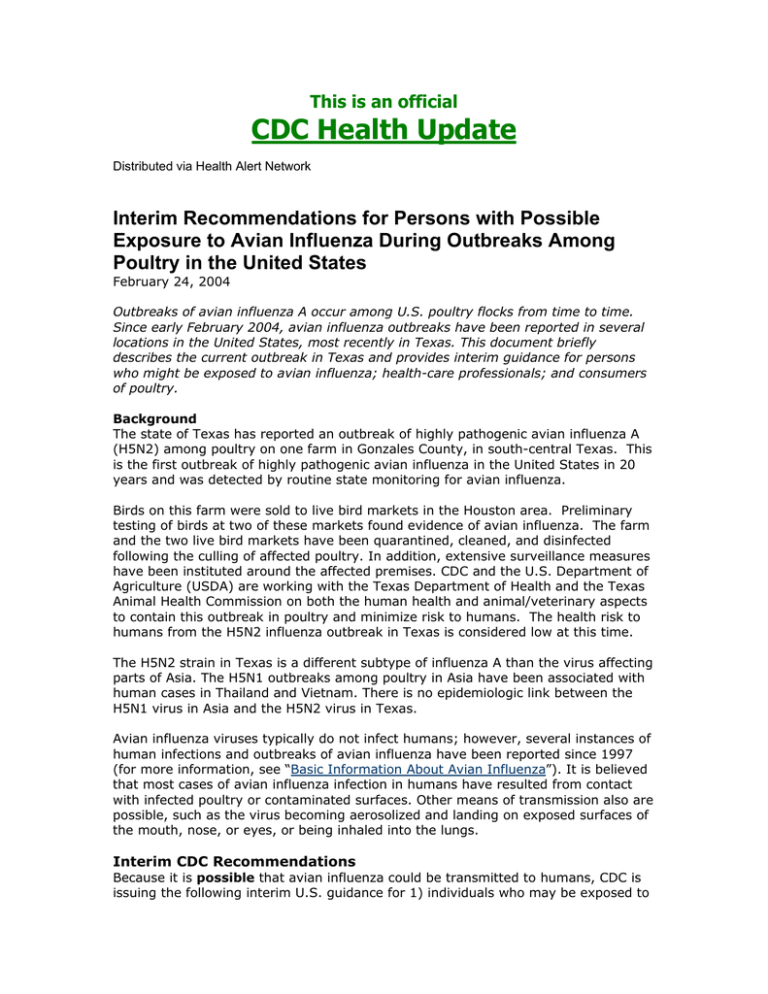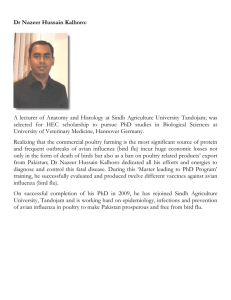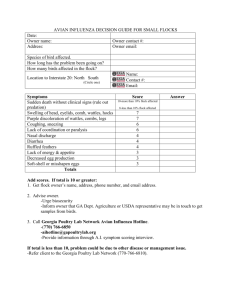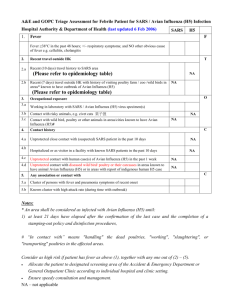CDC Health Update
advertisement

This is an official CDC Health Update Distributed via Health Alert Network Interim Recommendations for Persons with Possible Exposure to Avian Influenza During Outbreaks Among Poultry in the United States February 24, 2004 Outbreaks of avian influenza A occur among U.S. poultry flocks from time to time. Since early February 2004, avian influenza outbreaks have been reported in several locations in the United States, most recently in Texas. This document briefly describes the current outbreak in Texas and provides interim guidance for persons who might be exposed to avian influenza; health-care professionals; and consumers of poultry. Background The state of Texas has reported an outbreak of highly pathogenic avian influenza A (H5N2) among poultry on one farm in Gonzales County, in south-central Texas. This is the first outbreak of highly pathogenic avian influenza in the United States in 20 years and was detected by routine state monitoring for avian influenza. Birds on this farm were sold to live bird markets in the Houston area. Preliminary testing of birds at two of these markets found evidence of avian influenza. The farm and the two live bird markets have been quarantined, cleaned, and disinfected following the culling of affected poultry. In addition, extensive surveillance measures have been instituted around the affected premises. CDC and the U.S. Department of Agriculture (USDA) are working with the Texas Department of Health and the Texas Animal Health Commission on both the human health and animal/veterinary aspects to contain this outbreak in poultry and minimize risk to humans. The health risk to humans from the H5N2 influenza outbreak in Texas is considered low at this time. The H5N2 strain in Texas is a different subtype of influenza A than the virus affecting parts of Asia. The H5N1 outbreaks among poultry in Asia have been associated with human cases in Thailand and Vietnam. There is no epidemiologic link between the H5N1 virus in Asia and the H5N2 virus in Texas. Avian influenza viruses typically do not infect humans; however, several instances of human infections and outbreaks of avian influenza have been reported since 1997 (for more information, see “Basic Information About Avian Influenza”). It is believed that most cases of avian influenza infection in humans have resulted from contact with infected poultry or contaminated surfaces. Other means of transmission also are possible, such as the virus becoming aerosolized and landing on exposed surfaces of the mouth, nose, or eyes, or being inhaled into the lungs. Interim CDC Recommendations Because it is possible that avian influenza could be transmitted to humans, CDC is issuing the following interim U.S. guidance for 1) individuals who may be exposed to avian influenza, 2) health-care professionals, and 3) consumers of poultry. Guidance for individuals who may be exposed to avian influenza is based on the degree of risk associated with various levels and types of exposures. This document also contains interim guidance for health-care professionals who may need to evaluate, test, and diagnose potentially exposed individuals. Additionally, food safety information for consumers is provided to address concerns surrounding avian influenza outbreaks and poultry. The recommendations will be updated as necessary. Individuals Participating in Avian Influenza Outbreak Control and Eradication Activities Persons involved in outbreak control and eradication activities (e.g., euthanasia, carcass disposal, and cleaning and disinfection of premises affected by avian influenza) on poultry farms or live bird markets are at increased risk for exposure to avian influenza. Such persons often have prolonged, direct contact with infected birds and/or contaminated surfaces in an enclosed setting. CDC and USDA have developed interim guidance to reduce these risks, including recommendations about personal protective equipment, vaccination with seasonal influenza vaccine, administration of antiviral drugs for prophylaxis, surveillance and monitoring of workers, and evaluation of workers who develop a febrile respiratory illness within 7 days of their last exposure (available at http://www.cdc.gov/flu/avian/protectionguid.htm). Other Individuals with Possible Exposure to Avian Influenza The risks for exposure to avian influenza viruses and the possibility of viral reassortment would be expected to be lower for persons with more routine (i.e., less intense and prolonged) occupational or other types of contact with poultry or contaminated surfaces or equipment on affected farms or in live bird markets. Individuals who develop a febrile respiratory illness within a week after their last exposure to avian-infected or exposed birds or potentially contaminated surfaces should consult a health-care provider. Before visiting a health-care setting, tell the provider about symptoms and recent possible exposures to avian influenza. Health-Care Professionals: Evaluation of Ill Persons Health-care providers should be alert for respiratory illness among persons who may have been exposed to infected poultry. The following section provides recommendations for health-care professionals who may need to evaluate symptomatic persons with possible avian influenza exposure. • Persons who develop a febrile respiratory illness should have a respiratory sample (e.g., nasopharyngeal swab or aspirate) collected. • The respiratory sample should be tested by RT-PCR for influenza A, and if possible for H1 and H3. If such capacity is not available in the state, or if the result of local testing is positive, then CDC should be contacted and the specimen should be sent to CDC for testing. • Virus isolation should not be attempted unless a biosafety level 3+ facility is available to receive and culture specimens. • Optimally, an acute- (within 1 week of illness onset) and convalescent-phase (after 3 weeks of illness onset) serum sample should be collected and stored locally in case testing for antibody to the avian influenza virus should be needed. • Requests for testing should come through the state and local health departments, which should contact the CDC Director’s Emergency Operations Center at 770488-7100 before sending specimens for testing. Consumers: Food Safety Guidance There is no evidence that any human cases of avian influenza have been acquired by eating poultry products. Influenza viruses such as H5N2, H7N2, and H5N1 are destroyed by adequate heat, as are other foodborne pathogens. Consumers are reminded to follow proper food preparation and handling practices, including: • Cook all poultry and poultry products (including eggs) thoroughly before eating. (This means that chicken should be cooked until it reaches a temperature of 180 degrees Fahrenheit, throughout each piece of chicken.) • Raw poultry always should be handled hygienically because it can be associated with many infections, including salmonella. Therefore, all utensils and surfaces (including hands) that come in contact with raw poultry should be cleaned carefully with water and soap immediately afterwards. The World Health Organization has developed food safety guidance for the current situation in Asia. This is available at http://www.who.int/foodsafety/micro/avian/en/ . For More Information • Centers for Disease Control and Prevention website at http://www.cdc.gov/flu/avian/index.htm • The Animal and Plant Health Inspection Service website of the U.S. Department of Agriculture (at http://www.aphis.usda.gov/lpa/issues/ai_de/ai_de.html). • The Texas Animal Health Commission (at http://www.tahc.state.tx.us).







